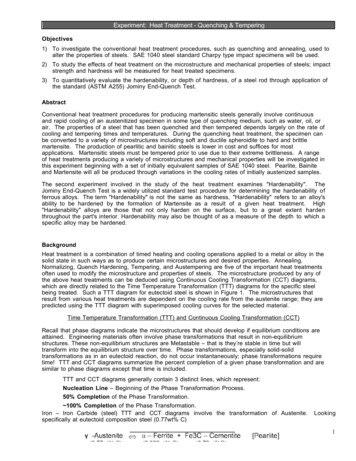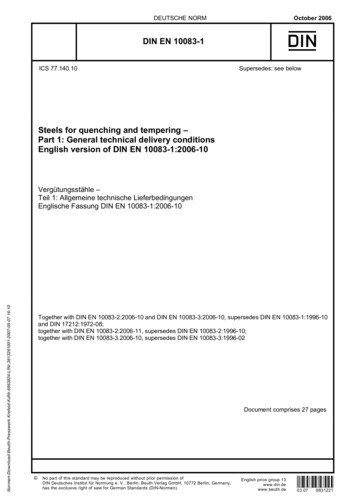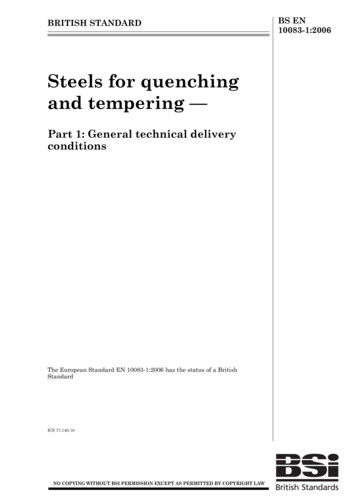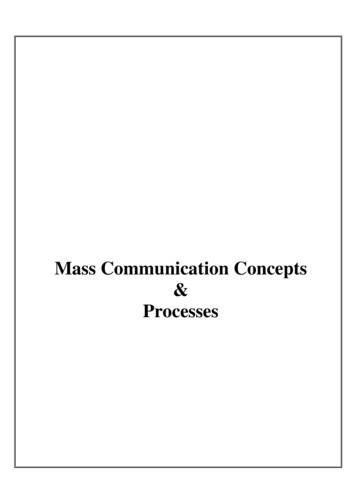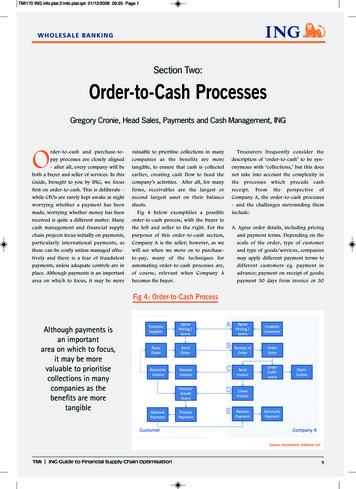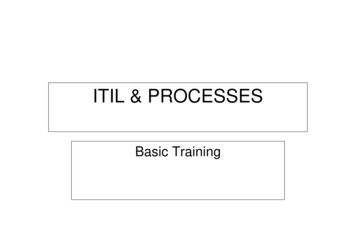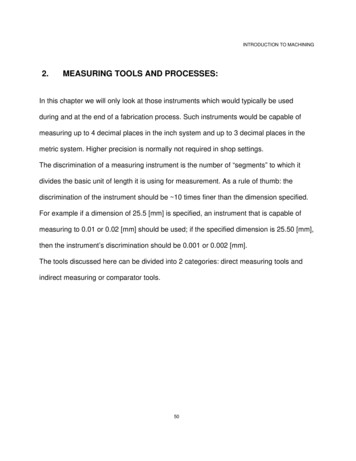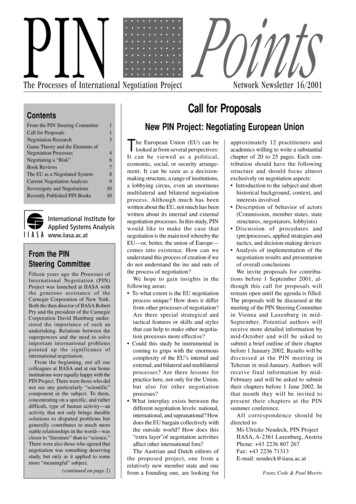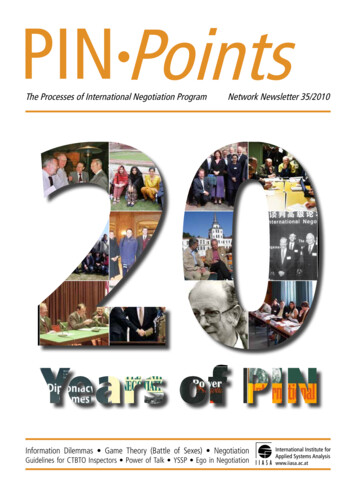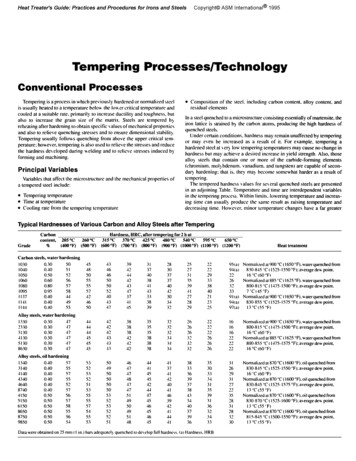
Transcription
Tempering is a process in which previously hardened or normalized steelis usually heated to a temperature hclocr the IOU er critical temperature andcooled al a suilable rate. primarily to increase ductility and toughness. hutalso to increase the grain size of the matrix. Steels are tempered b)reheating after hardening to obtain specific Lalues of mechanical propertiesand also to relieve quenching stresses and to ensure dimensional stahilitj.Tempering usually follows quenching from above the upper critical temperature; hoNever, tempering is also used to relieve the stresses and reducethe hardness developed during ueldinp and to relisve stresses induced b)fomling and machining.PrincipalVariablesVariables that affect the microstructurea tempered steel include:lllTempering temperatureTime at temperatureCooling rate from the 5657ss441955steels, Alloysteels, oil 098500.400.10O.-IO0.400.500.50OS0050o.so050260 ‘ C(500 F)carbon content, alloy content, andln a steel quenched to a microstructure consisting essentially of martensite, theiron lattice is strained b) the carbon atoms, producing the high hardness ofquenched steels.Under certain conditions. hardness may remain unaffected hy temperingor may even be increased as a result of it. For example, tempering ahardened steel at I eq low tempering temperatures may cause no change inhardness but may achieve a desired increase in yield strength. Also, thoseallo) steels that contain one or more of the carhide-formingelements(chromium. molybdenum.vanadium. and tungsten) are capable of secondq hardening: that is. they ma) become somewhat harder as a result oftempering.The tempered hardness \ alues for se\ eral quenched steels are presentedin an adjoining Table. Temperature and time are interdependent variablesin the tempering process. Within limits. lowering temperature and increasing time can usualI! produce the same result as raising temperature anddecreasing time. However, minor temperature changes have a far greater315T(6OOT)37OT(700 FjJ25Ttemperiagfor 2 hat48OT-540 T595 T650 T@OO F) (9OO’ F)(lOOO F) (1100 F) (1200 F)Heat ompositionof the steel. includingresidual elementsCarbon and Alloy Steels after TemperingHardness, HRC, ertiestemperatureof Various205 T(.WO”F)steels, water31-U)and the I433338392830373740-123031329513) Normalized at 900 C (1650 F). waterquenched from830 X-iS“C(l525-15SO”F):s eragedeapoint.94cIJ7216”Cl60”F,Normalized a 885 “C I I625 “F). water quenched From267’800-81.5 “C (1175.15OO”F):a\rrage dew poim.;;7“Ct4S”F)91ta1 Normali dur 900 “C Il650”F . waterquenched from830-855 “C 1 I SZS- I S7S “F); average dew 51184245 39363-l3135393136323-t33Data were obtained on 25 null t I in.) bars adequateI) quenched wdc\elopfull hzdnejs. (a Hardness. HRB311619312737ii1831283’lolB”Cl55”F1at 900 “C ( 1650 F). water quenched fmm800-815 “C(I-175-1500”F):a\er gedewpoint,16”Ct6O”F)Normalized at 88S “C ( 1625 OF),water quenched from8004355 “Cl l-l7S-lS7S “F);areragedew point.NormtiredI6 “C (60 “F)Normalized at 870 “C t 1600 “F). oil quenched humX30-849 “C I ISIS- I550 “F); average dew point.l6’ C (60 F)Normalized at 870 “C (1600 “F). oil quenched from830-845 “C ( 1525. I575 “F): average dew point.I3 “C (5.5 “F)Normalizcda1870”C( 1600”F),oiIquenchedfrom830-870 ‘C t I SZS-I600 “F); aLerage deu point.13”CtSS’F)Normalized at 870 “C ( 1600 F). oil quenched from8 1%845 “C t IYJO- lSSO”F): average dew point.13”C155”F,
Temperingeffect than minor time changes in typical tempering operations. With fewexceptions, tempering is done at temperatures between 175 and 705 “C(315 and I300 “F) and for times from 30 min to 1 h.Structural Changes. Based on x-ray, dilatometric. and microstructural studies, there are three distinct stages of tempering, even though thetemperature ranges overlap (Ref I-4):lllStage I: The formation of transition carbides and lobering of the carboncontent of the martensite to 0.1SQ ( 100 to 250 “C, or 310 to 480 “F)Stage II: The transformationof retained austenite 10 ferrite and cementite(200 to 300 “C. or 390 to 570 “F)Stage IfI: The replacement of transition carbides and low-temperaturemartensite by cementite and ferrite (250 to 350 “C. or 180 to 660 “F)An additionalstage of tempering (stage IV). precipitationof fineI dispersed alloy carbides, exists for high-alloy steels. It has been found thatstage I of tempering is often preceded by the redistributionof carbon atoms.called autotempering or quench tempering, during quenching and/or holding at room temperature (Ref 5). Other structural changes take placebecause of carbon atom rearrangement preceding the classical stage I oftempering (Ref 6,7).DimensionalChanges. Martensite transformation is associated withan increase in volume. During 1empering. martensite decomposes into amixture of ferrite and cementite with a resultant decrease in volume astempering temperature increases. Because a 100% martensitic structureafter quenching cannot always be assumed, volume may not continuous11decrease with increasing tempering temperature.The retained austenite in plain carbon steels and low-alloysteels transforms to bainite with an increase in volume, in stage II of tempering. Whencertain alloy steels are tempered. a precipitationof finely distributed allo)carbides occurs. along with an increase in hardness, called secondqhardness, and an increase in volume. With the precipitationof allo) carbides. the MS temperature (temperature at which martensite starts to fomlfrom austenite upon cooling) of the retained austenite will increase andtransform to martensite during cooling from the tempering temperature.Tempering Temperature.Several empirical relationships have beenmade between the tensile strength and hardness of tempered steels. Themeasurement of hardness commonI is used to evaluate the response of asteel to tempering. An adjoining Figure shous the effect of temperingEffect of temperingtemperatureof 1050 steel that was forgedheat: 0.52% C, 0.93% Mnon room-temperatureto 38 mm (1 SO in.) in diameter,mechanicalthen waterProcesses/Technology/ 97temperature on hardness, tensile and yield strengths, elongation, and reduction in area of a plain carbon steel (AISI 1050) held at temperature for I h.It can be seen that both room-temperaturehardness and strength decreaseas the tempering temperature is increased. Ductility at ambient temperatures. measured by either elongation or reduction in area, increases withtempering temperature.hlost medium-allo)steels exhibit a response to tempering similar to thatof carbon steels. The change in mechanical properties with temperingtemperature for 4330 steel is shorn n in an adjoining Figure.There is no decrease in ductility in the temperature range of temperedmartensite embrittlement.or ThIE (also known as 160 “C [SO0 “F] embrittlsment or one-step temper embrittlement)because the tensile tests areperformed on smooth. round specimens at relativelylow strain rates.Home\sr. in impact loading. catastrophicfailure may result when alloysteel is tempered in the tempered martensite embrittlementrange (260 to370 “C. or SO0 to 700 “F).H’hereas elongation and reduction in area increase continuouslywithtempering temperature. toughness. as measured by a notched-bar impacttest. \ aries uith tempering temperature for most steels, as shown in anadjoining Figure. Tempering at temperatures from 260 to 320 “C (500 to610 “F) decreases impact energy to a value below that obtained at aboutIS0 “C (300 “F). Above 320 “C (610 “F), impact energy again increasesmith increasing tempering temperature. Both plain carbon and alloy steelsrespond IO tempering in this manner. The phenomenon of impact energycentered around 300 YY (570 ‘Fj is called tempered martensite embrittlement (ThlE) or 160 “C (SO0 “F) embrittlement.Tempering Time. The difisionof carbon and alloying elements necessarj for the formation of carbides is temperature and time dependent. Theeffect of tempering time on the hardness of a 0.828 C steel tempered atvarious temperatures is shown in an adjoining Figure. Changes in hardnessare approximateI)linear over a large portion of the time range when thetime is presented on a logarithmic scale. Rapid changes in room temperature hardness occur at the start of tempering in times less than IO s. Lessrapid. but still large. changes in hardness occur in times from I to IO min.and smaller changes occur in times from I IO 2 h. For consistency and lessdependency on variations in time. components generally are tempered forI to 2 h. The levels of hardness produced by very short tempering cycles,propertiesof 1050 steel. Propertiesquenchedand temperedat varioussummarizedtemperatures.are for one heatCompositionof
98 / Heat Treater’sGuideEffect of temperingtemperatureon the mechanicalproperties of oilquenched4340 steel bar. Single-heat results: ladlecomposition, 0.41% C. 0.67% Mn, 0.023% P, 0.018% S, 0.26% Si,1.77% Ni, 0.78% Cr, 0.26% MO; grain size, ASTM 6 to 8; criticalpointsAc,, 770 C (1420”F);Ar,, 475 C (890 F); Ar,, 380 C (720“F); treatment, normalized at 870 “C (1600 “F), reheated to 800 “C(1475 “F), quenched in agitated oil; cross section, 13.46 mm(0.530 in.) diam; round treated, 12.83 mm (0.505 in.) diam; roundtested; as-quenched hardness, 601 HB. Source: Ref 8Notch toughness as a function of tempering temperaturefor4140 (UNS G41400) ultrahigh-strengthsteel tempered 1 hAlloy ContentCarbon ContentThe main purpose of adding alloying elements to steel is to increasehardenability(capability to form martensite upon quenching from above itscritical temperature). The genera) effect of alloying elements on temperingis a retardation of the rate of softening, especially at the higher temperingtemperatures. Thus. to reach a given hardness in a given period of time,alloy steels require higher tempering temperatures than do carbon steels.Alloying elements can be characterized as carbide forming or non-carbide forming. Elements such as nickel, silicon, aluminum. and manganese,which have little or no tendency to occur in the carbide phase, remainessentiallyin solution in the ferrite and have only a minor effect ontempered hardness. The carbide forming elements (chromium, molybdenum. tungsten, vanadium, tantalum. niobium, and titanium) retard thesoftening process by the formation of alloy carbides.Strong carbide-formingelements such as chromium, molybdenum, andvanadium are most effective in increasing hardness at higher temperaturesabove 205 “C (100 “F). Silicon was found to be most effective in increasinghardness at 3 I5 “C (600 “Fj. The increase in hardness caused by phosphorus, nickel. and silicon can be attributed to solid-solutionstrengthening.Manganese is more effective in increasing hardness at higher temperingtemperatures. The carbide-formingelements retard coaJescence of cementite during tempering and foml numerous small carbide particles. Undercertain conditions, such as with highly alloyed steels, hardness may actually increase. This effect, mentioned previously.is known as secondaryhardening.Other Alloying Effects. In addition to ease of hardening and secondary hardening. alloying elements produce a number of other effects. Thehigher tempering temperatures used for alloy steels presumably permitgreater relaxation of residual stresses and improve properties. Furthermore,the hardenabilityof alloy steels requires use of a less drastic quench so thatquench cracking is minimized. However, higher hardenabilitysteels areprone to quench cracking if the quenching rate is too severe. The higherhardenabilityof alloy steels may also permit the use of lower carboncontent to achieve a given strength level but with improved ductility andtoughness.Residual Elements. The elements that are known to cause embrittlement are tin. phosphorus. antimony, and arsenic.The principal effect of carbon content is on as-quenched hardness. Anadjoining Figure shows the relationshipbetween carbon content and themaximum hardness that can be obtained upon quenching. The relativedifference in hardness compared with as-quenched hardness is retainedafter tempering. An adjoining Figure shows the combined effect of time.temperature, and carbon content on the hardness of three carbon-molybdenum steels of different carbon contents. Another Figure shows the hardnessof these steels after tempering for I h. as a function of tempering temperature. The effect of carbon content is evident.furnaces or in moltensalt. hot oil. or molten metal baths. The selection of furnace type dependsprimarily on number and size of parts and on desired temperature. Temperature ranges. most likely reasons for use. and fundamental problemsassociated with four types of equipment are given in an adjoining Table.Selective tempering techniques;LTeused to soften specific areas offully hardened parts or to temper areas that were selectivelyhardenedpreviously.The purpose of this treatment is to improve machinability,toughness, or resistance to quench cracking in the selected zone.such as in induction tempering, would be quite sensitive to both thetemperature achieved and the time at temperature.By the use of an empirical tempering parameter developed by Hollomanand Jaffe (Ref IO), the approximate hardnesses of quenched and temperedlow- and medium-alloysteels can be predicted. Reasonably good correlations are obtained except when significant amounts of retained austeniteare present.Coolin
Effect of tempering temperature on room-temperature mechanical properties of 1050 steel. Properties summarized are for one heat of 1050 steel that was forged to 38 mm (1 SO in.) in diameter, then water quenched and tempered at various temperatures. Composition of heat: 0.52% C, 0.93% Mn
